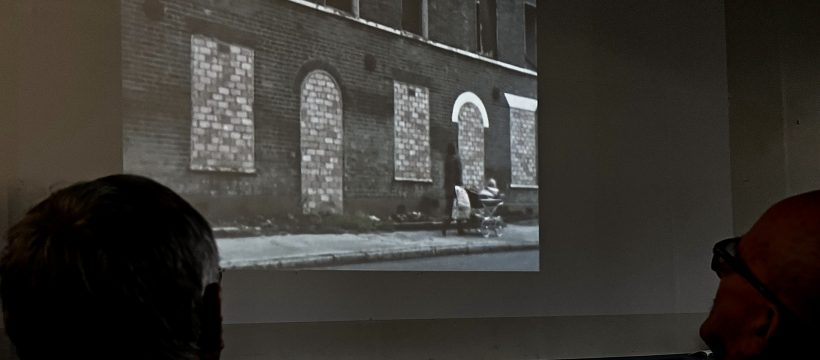On Tuesday afternoon the Tower Hamlets branch of the U3A in conjunction with the Tower Hamlets Archives in Bancroft Road showed the film Goodbye Longfellow Road. It was made by Yorkshire Television and transmitted in 1977. It depicts the demolition of streets of houses near Clinton Road in Bow to create a section of Mile End Park.
The film opens with bailiffs and the police evicting squatters from what today would be million pound three storey houses. Back then they were allowed to decay under the GLC and had been passed on for free to 2nd Genesis Housing Association and then to NOVO housing association. The GLC had compounded the corruption by giving the housing associations grants to carry out work which they did not do! Meanwhile social security were paying the housing associations £14 a week rent to house needy people in insanitary conditions.
Tenants who complained got nowhere and in some cases were beaten up.
This was a brilliant piece of undercover journalism and fly-on-the-wall style filmmaking.
A big thank you goes to the organisers for showing this film.
Alan Tucker



Hi my parents lived in Longfellow Rd I can’t remember the number but it was mid way down on the left. They were Peter and Louie Howard. We moved to Kent when I was about 8 yrs old ( now 71)
My brother took over the rental, and his name was Johnnie Doe with his wife Pat.
If anyone remembers my parents or brother it would be great to hear from you.
I found the documentary on YouTube. So sad to see what became of those old houses. People use to take pride in them when I was growing up they didn’t have much but they took pride in what little they had.
Hi Micky,
Long time since we’ve seen each other, yes it’s young Roy. I’ve put a post on here a few months ago. I have a copy of “Good bye Longfellow Road” on dvd. Try to give me contact details. This ain’t no joke. Nan’s name was Annie Newson, fathers name was Jack. I ain’t heard anything thing from the others, I know Johnny got married again several years ago.
Michael, it’s recently been uploaded to youtube.
I remember Longfellow road when i was younger, i lived in Clinton Road, i remember the Bonfire and seeing myself on the Film
31. Goodbye Longfellow Road – Finding Community as a London Squatter in the ‘70s
I arrived in London to start teaching at the end of August 1975, not knowing a soul. I wandered around the East End looking for somewhere to live. That night I slept in a convent that provided housing for homeless people. It was looking grim.
The next day I bumped into George, an old Somerset friend, at Brick Lane Market and stayed the night at his squat in Mile End. He told me about a derelict house in Longfellow Road a few streets away. Early next morning I went to look for a home. As I walked down the street, two guys came up behind me – they too were wanting to squat. We introduced ourselves. Then Simon, Ian and I broke into number 30 and changed the lock. Jenny joined us later.
The house was solid but in a real state – no electricity, gas or water with broken windows and floorboards. There was an outside loo but the council had poured concrete in it to stop squatters. Within an hour we had moved our backpacks in and started renovating. Our Hare Krishna neighbors helped us hook up to electricity and we used their loo. We bought a bath from Brick Lane Market but had no water. For my first week teaching, I had to wash in the school toilets. Of course, I told no one. By Christmas, our house was so comfortable that Mum, a middle-class farmer’s wife from Somerset came to stay and felt quite at home.
According to the New York Times, due to the housing shortage and high rents, there were 30,000 squatters in London in 1975. Thanks to a law made by Richard II, squatting was legal at the time.
Our road was a cul-de-sac of squatters – doctors, nurses, teachers, artists, young families, old residents and a few misfits. We had our own food co-op and held fabulous street parties with a stage and live bands. There was a real sense of community.
The council wanted development and corruption reigned. We did all that the Squatters Handbook, a DIY guide to squatting, recommended to try to get licensed as an official housing association.
The street backed onto a canal and one night the National Front threw Molotov cocktails into the house of a gay couple who lived a few doors down. In response, the street formed a “vigilante” group to protect the community from further attacks.
I lived in Mile End until Nov 1976 and returned in 1979 to find only one house standing with “Goodbye Longfellow Road” painted on it in big red letters. It was an emotional shock to see our vibrant community gone. I
The Squatting laws changed in 1976 and again in 2012 so now it is even harder for homeless people to find safe places to live.
Reflecting on that period, I’m somewhat astonished at how nonchalant I was. It’s highly unusual to encounter two strangers on the street and then, just five minutes later, break into a house with them and live with them for the next year. However, that feeling of togetherness and newness made squatting such an exciting exploit.
Frankie Sutton (nee Ridout)
Longfellow road has many good memories for me. I was brought up there for a while at number 67 and even learnt to play my grandparents piano. Number 67 was my grandparent house and my great grandmother lived a few doors away from her. I also had most of my aunt’s and uncle’s living in the same street.
I cannot find a copy of the recording anywhere of this documentary, I tried Tower Hamlets Council but no joy there. Is there any way, that you know of, where I can get a copy on DVD so I can give a copy to my children and Grand-children so they can see the place where I spent some of my early years and where their great great grandparents and great grandparents lived? – I am now 67 years young.
My grandmother was called Anne Newson and from what I recall of the “Goodbye Longfellow Road” documentary, when I first saw it, she appeared quite prominently throughout that documentary.
From: Francis Murphy
Hi there. I was a refugee from War torn Belfast in the 70’s and was helped greatly by the community in the East End.
I lived in a squat in Longfellow road when the documentary was made. I didn’t feature in it but had got to know the family down the street who took part. They were lovely people.
Keep up the good work!
Me and my parents lived at 67 Longfellow Road, and my aunt, uncle and great gran lived at 69 Longfellow Road. We were one of the last of six families to leave the road. Our landlord didn’t want to give up the property. We had many years of good times there. My mum (Mrs Annie Newson) and aunt (Mrs Esther Green) are in this documentary, they are the ladies standing in the doorway doing an interview to the camera, my aunt is the one with the glasses. I also appeared in this documentary, I was the young lad with brown hair and wearing a blue bomber jacket with red and white stripes around the tops of the sleeves, on a bright red new Raleigh Chopper. I had that bike right up until 1981. We were moved to Milton Keynes when they moved us out, I’m getting teary eyed remembering everyone. Sadly all the family have passed away now, I’m the only one left. The Newson line ends with me. Why why why did they have to flatten the place and move all our families to god now’s where.
My family lived at 63 Longfellow rd…
Who’s stupid idea was that to knock down all those houses and put a useless strip of grass from St. Paul’s way up to victory park
Must have been lots of back handers going on back then
I remember it going on as I still lived just off burdet rd back in 1963-76
Keith